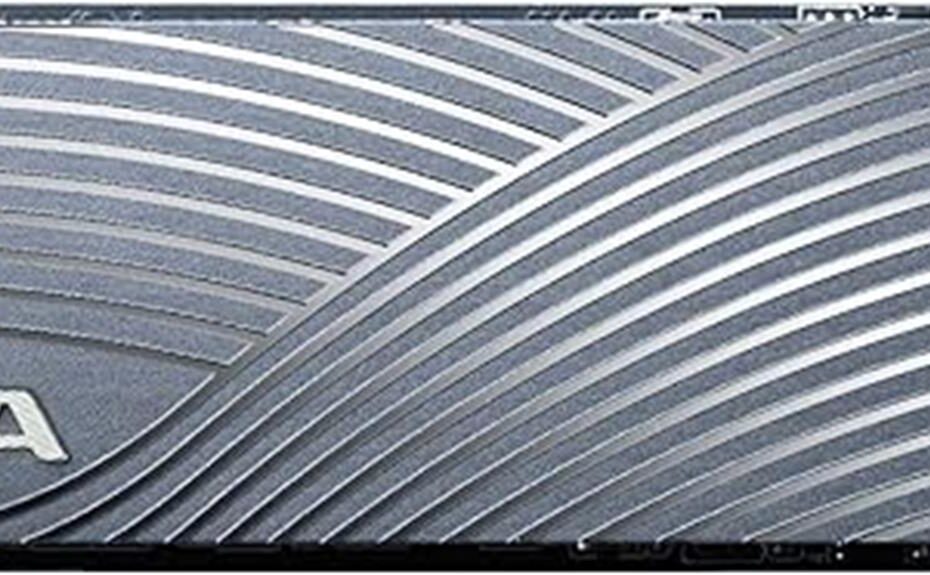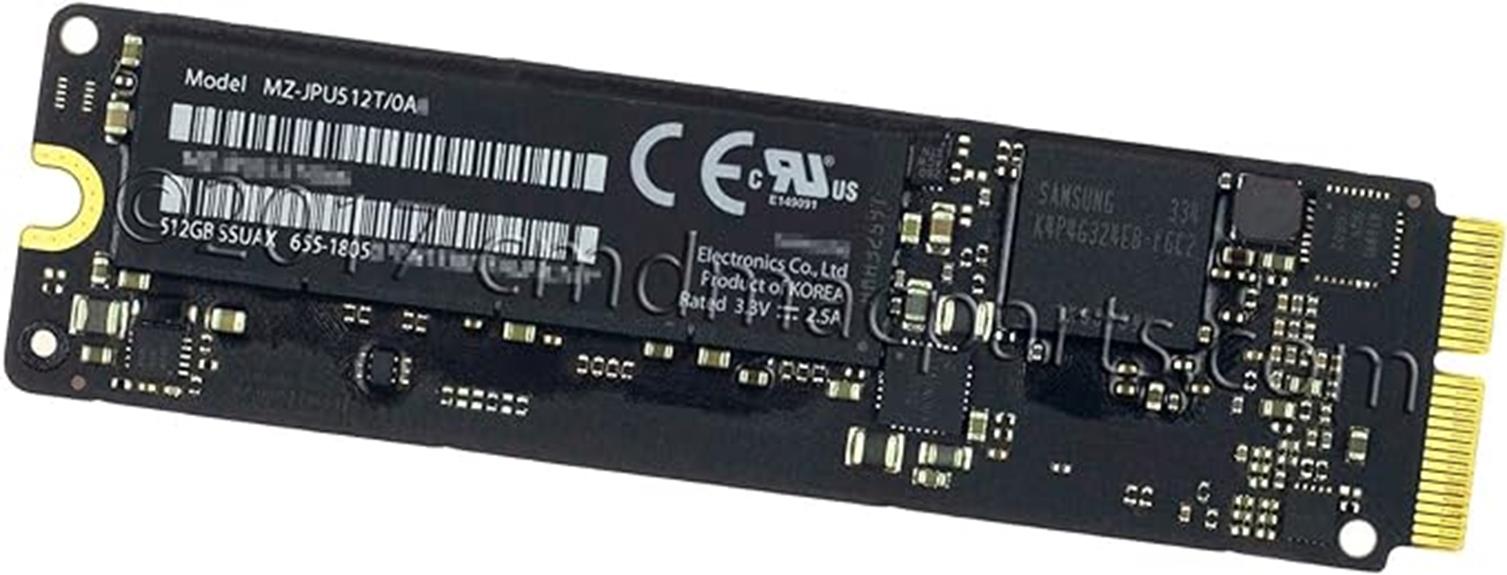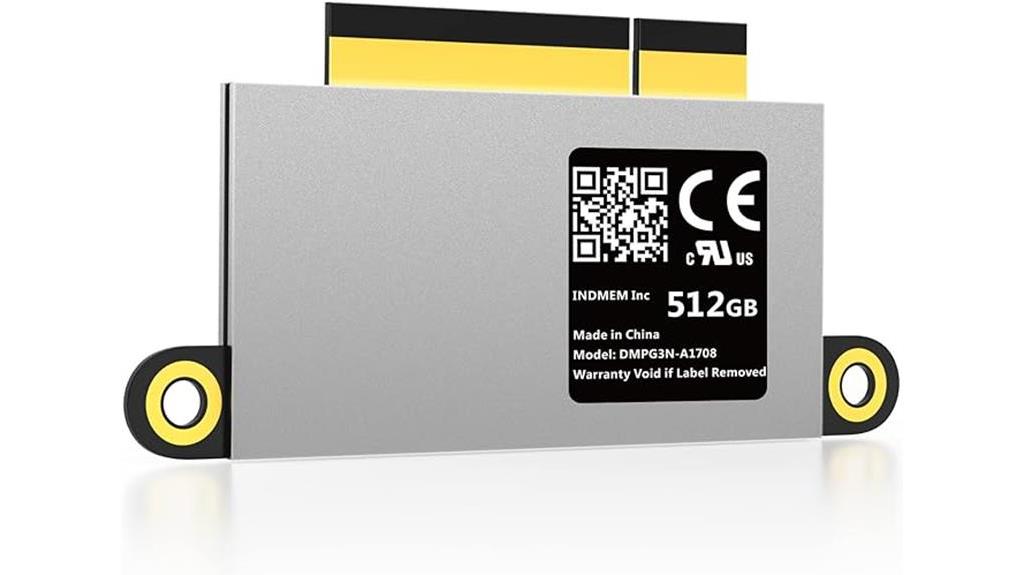





When it comes to high-performance storage, the ADATA Swordfish SSD has garnered significant attention for its impressive specifications, boasting a substantial 2TB capacity and rapid read/write speeds of up to 1800/1200MB/s. On paper, it seems like an ideal solution for professionals, gamers, and data enthusiasts alike. However, a closer examination of customer feedback reveals a more nuanced picture, with reports of overheating, system crashes, and compatibility issues with certain motherboards. As we explore the Swordfish's features, product quality, and customer experiences, a crucial question emerges: does this SSD's potential outweigh its limitations, or are there better options available?
Key Takeaways
- The ADATA Swordfish SSD has mixed customer reviews, with reports of overheating, compatibility issues, and system crashes affecting its performance.
- Despite its impressive sequential read and write speeds of up to 1800MB/s and 1200MB/s, respectively, the SSD's random 4K read/write speeds and endurance rating are less impressive.
- The SSD's compatibility issues are a major concern, with some motherboards experiencing problems, and its reliability is also questionable due to reported system crashes and data loss.
- The 2TB storage capacity and 5-year limited warranty are notable pros, but the SSD's overall value is compromised by its inconsistent performance and technical issues.
- To get the best results from the ADATA Swordfish SSD, users should follow proper installation and maintenance guidelines, ensure peak operating conditions, and perform regular maintenance tasks to minimize risks.
The ADATA Swordfish SSD, part of the ASWORDFISH-2T-C series, boasts an impressive set of specifications, featuring an M.2 2280 PCIe Gen3x4 NVMe 1.3 interface and capable of delivering read and write speeds of up to 1800MB/s and 1200MB/s, respectively. However, customer feedback highlights concerns regarding compatibility issues and overheating, with some users reporting system crashes and incompatibility with certain motherboards. When it comes to performance, the Swordfish SSD's reliability is a subject of debate, with some users recommending alternative options due to inconsistent results. A thorough examination of its performance comparison to other ADATA SSD models is necessary to determine its reliability and value in the market.
Features and Benefits
The ADATA Swordfish boasts an array of features designed to enhance performance and capacity. It employs SLC Caching to accelerate write speeds, with its Host Memory Buffer Boost optimizing data transfer. Additionally, the Swordfish supports the NVMe 1.3 interface and offers a substantial 2TB storage capacity, making it a formidable storage solution.
SLC Caching for Speed
ADATA's Swordfish SSD leverages SLC caching to accelerate write performance, allocating a portion of the drive's capacity to single-level cell flash memory that can handle data at speeds of up to 1800MB/s. This speed optimization technique enables the drive to temporarily store and process data at higher speeds, resulting in enhanced write performance. The SLC cache acts as a buffer, allowing the drive to handle bursts of data-intensive tasks more efficiently. By utilizing SLC caching, the Swordfish SSD achieves improved performance enhancement, making it suitable for applications that require high-speed data transfer, such as video editing and 3D modeling. This feature is particularly useful for users who require fast write speeds, making the Swordfish SSD a viable option for those seeking high-performance storage solutions.
Host Memory Buffer Boost
Leveraging a host memory buffer boost, the Swordfish SSD optimizes its performance by utilizing a small amount of system RAM to accelerate data transfer, thereby enhancing overall storage efficiency. This memory buffer optimization enables the SSD to efficiently handle data-intensive tasks, resulting in improved performance benchmarks. By allocating a portion of system RAM as a buffer, the Swordfish SSD can temporarily store data before writing it to the storage drive, thereby reducing latency and increasing throughput. This feature is particularly beneficial in scenarios where high-speed data transfer is essential, such as video editing and 3D modeling. The host memory buffer boost allows the Swordfish SSD to maintain its performance edge, even under demanding workloads.
NVMe 1.3 Interface Support
Built upon the foundation of its host memory buffer boost, the Swordfish SSD's NVMe 1.3 interface support enables the drive to tap into the full potential of modern systems, facilitating blistering-fast data transfer rates and reduced latency. This cutting-edge interface technology allows for efficient data transfer, making it an attractive feature for those seeking high-performance storage solutions. However, some users have reported compatibility issues with certain motherboards, which may hinder the drive's ability to reach its maximum potential. Additionally, performance concerns have been raised, with some users experiencing slower-than-expected read and write speeds. These issues must be addressed to fully realize the benefits of the NVMe 1.3 interface support.
TB Storage Capacity
With a substantial 2TB storage capacity, the Swordfish SSD offers users a vast expanse of digital real estate to house their ever-expanding collections of files, programs, and multimedia assets. This generous capacity enables users to store a large number of files, reducing the need for frequent data transfers and backups. However, it is crucial to evaluate the performance comparison of the Swordfish SSD with other models in its class. Despite its impressive storage capacity, some users have reported compatibility concerns, including issues with overheating and system crashes. These concerns may impact the overall performance of the SSD, highlighting the necessity for careful examination of its specifications and limitations before making a purchase.
Product Quality
The Swordfish's product quality is a subject of concern, as reflected in the mixed customer reviews and reported issues with overheating, compatibility, and system crashes, which have led some users to question its reliability and recommend alternative SSDs. Reliability concerns arise from the frequency of system crashes and data loss, casting doubt on the drive's ability to perform consistently. Compatibility issues with certain motherboards have also been reported, further complicating the installation and operation of the Swordfish. These problems undermine the confidence of potential buyers, making it essential for ADATA to address these concerns and improve the overall product quality to regain customer trust.
What It's Used For
The ADATA Swordfish SSD is designed to cater to various use cases, including demanding applications such as gaming and video editing, where high-speed storage is essential. Additionally, it is also suitable for everyday computing tasks, providing a significant boost in performance and responsiveness. Moreover, the Swordfish SSD can also be used to meet storage expansion needs, offering a reliable and high-capacity solution for users seeking to upgrade their existing systems.
Gaming and Video Editing
ADATA's Swordfish SSD excels when it comes to meeting the demanding storage needs of gaming and video editing applications, where rapid data access and transfer are essential for seamless performance. When considering performance benchmarks, the Swordfish boasts impressive sequential read and write speeds of up to 1800MB/s and 1200MB/s, respectively. However, some users have reported compatibility issues with certain motherboards, which can lead to system crashes and overheating. Despite this, the Swordfish's SLC caching and host memory buffer enable efficient handling of large files and 4K video editing. Nevertheless, users should be cautious when pairing the Swordfish with their system, ensuring compatibility before making a purchase.
Everyday Computing Tasks
Beyond gaming and video editing, the Swordfish SSD is well-suited for everyday computing tasks, including booting up operating systems, launching applications, and storing files, where its high sequential read and write speeds can greatly reduce loading times and enhance overall system responsiveness. When considering real-world usage, the Swordfish's performance is commendable, with fast file transfer rates and responsive system loading. However, some users have reported compatibility issues with certain motherboards, which may hinder its performance. A performance comparison with other ADATA SSD models reveals that the Swordfish falls short when it comes to random 4K read/write speeds. Reliability concerns also arise from reports of overheating and system crashes, which may impact its overall usability.
Storage Expansion Needs
Two terabytes of storage capacity make the Swordfish SSD an attractive solution for users seeking to expand their storage capabilities, especially in scenarios where large files and datasets need to be stored and accessed efficiently. This capacity enables seamless data transfer and management, making it an ideal storage solution for professionals and enthusiasts alike. The Swordfish SSD's high storage capacity also lends itself well to applications requiring massive data storage, such as video editing, 3D modeling, and virtual reality. As a reliable storage solution, the Swordfish SSD facilitates rapid data transfer, reducing wait times and increasing productivity. Its fast read and write speeds guarantee that users can access and store large files quickly, making it an excellent addition to any storage expansion needs.
Product Specifications
The ADATA Swordfish ASWORDFISH-2T-C series features a high-speed M.2 2280 PCIe Gen3x4 NVMe 1.3 interface, allowing it to reach impressive read and write speeds of up to 1800MB/s and 1200MB/s, respectively. This SSD boasts a 2TB capacity, 5-year limited warranty, and is designed for PC use.
| Specification | Value | Description |
|---|---|---|
| Interface | M.2 2280 PCIe Gen3x4 NVMe 1.3 | High-speed connection |
| Read/Write Speed | Up to 1800/1200MB/s | Impressive performance |
| Capacity | 2TB | Ample storage space |
| Warranty | 5 Year Limited | Extended warranty coverage |
| Hardware Platform | PC | Designed for PC use |
The Swordfish series is built with solid-state drive technology, ensuring reliable performance. However, compatibility issues and performance concerns have been reported by some users, highlighting the importance of careful consideration before purchase.
Who Needs This
High-performance enthusiasts and professionals seeking to upgrade their PC storage with a high-capacity, fast, and reliable solid-state drive solution may find the ADATA Swordfish ASWORDFISH-2T-C series an attractive option. This target audience includes gamers, video editors, and data analysts who require rapid data transfer rates and large storage capacities. The Swordfish's 2TB capacity and up to 1800MB/s read speed make it suitable for demanding use cases such as 4K video editing, 3D modeling, and virtual reality applications. Additionally, professionals working with large datasets, such as researchers and scientists, may benefit from the Swordfish's high-capacity storage and fast data transfer rates.
Pros
With its impressive read and write speeds of up to 1800MB/s and 1200MB/s, respectively, the ADATA Swordfish ASWORDFISH-2T-C series offers exceptional storage performance for demanding applications. This solid-state drive (SSD) is designed to provide improved performance, making it an excellent choice for professionals and gamers who need fast data access.
The ADATA Swordfish series boasts several advantages, including:
- Fast Data Transfer: With read and write speeds of up to 1800MB/s and 1200MB/s, respectively, this SSD guarantees rapid data transfer, reducing wait times and enhancing overall system performance.
- Reliable Compatibility: The Swordfish series is compatible with a wide range of devices, including PCs and laptops, making it a dependable storage solution for various applications.
- Large Storage Capacity: With a storage capacity of 2TB, this SSD provides ample space for storing large files, programs, and data, making it an ideal choice for users who need extensive storage.
Cons
Despite its impressive performance capabilities, the ADATA Swordfish ASWORDFISH-2T-C series has been plagued by several issues that may deter potential buyers. Among the most notable concerns are reliability issues, with some users reporting system crashes and data loss. Additionally, the SSD's compatibility with certain motherboards has been called into question, leading to frustrating installation and usage experiences.
Some of the key drawbacks of the ADATA Swordfish include:
- Overheating issues: Reports of excessive heat generation during intense usage have raised concerns about the SSD's long-term durability.
- System crashes and instability: Users have reported system crashes and freezes, which can be attributed to the SSD's compatibility issues or firmware problems.
- Reliability concerns: The likelihood of data loss and corruption due to the SSD's instability has led to concerns about its overall reliability.
What Customers Are Saying
Customer reviews of the ADATA Swordfish ASWORDFISH-2T-C series reveal a mixed bag of experiences, with some users reporting satisfactory performance while others encounter issues that erode confidence in the SSD's reliability. Many customer experiences are marred by compatibility concerns, with some users reporting issues with overheating, motherboard incompatibility, and system crashes. These issues have led some users to recommend alternative SSDs due to reliability concerns. Despite this, some users have reported satisfactory performance, with the SSD delivering on its promised read and write speeds. It is clear that the ADATA Swordfish ASWORDFISH-2T-C series has a divided user base, with some users experiencing seamless operation while others face frustrating technical issues.
Overall Value
The ADATA Swordfish ASWORDFISH-2T-C series' overall value is a complex calculation, weighing its promising performance specifications against the reliability concerns and technical issues reported by a significant portion of its user base. Despite its competitive pricing, the Swordfish's value is diminished by customer satisfaction issues and reliability concerns. A 5-year limited warranty provides some assurance, but it may not be enough to offset the reported overheating, compatibility problems, and system crashes. In a pricing comparison, the Swordfish's value is further eroded by the availability of alternative SSDs with similar performance and fewer technical issues. Ultimately, the Swordfish's overall value is compromised by its inconsistent performance and reliability concerns, making it a less attractive option for those seeking a reliable high-performance SSD.
Tips and Tricks For Best Results
To maximize the performance and reliability of the ADATA Swordfish ASWORDFISH-2T-C series, it is essential to follow proper installation and maintenance guidelines, ensuring peak operating conditions and minimizing the risk of overheating, compatibility issues, and system crashes. Installation tips include ensuring a secure M.2 connection, proper thermal management, and firmware updates. Troubleshooting steps should include checking for BIOS compatibility, disabling unnecessary features, and monitoring system temperatures. For performance optimization, users should enable SLC caching, maintain a healthy disk space, and avoid resource-intensive applications. Regular maintenance tasks, such as disk cleanups and error checks, can also help maintain the SSD's overall performance and longevity. By following these guidelines, users can optimize their ADATA Swordfish experience and minimize potential issues.
Conclusion
In addition, in conclusion, the ADATA Swordfish ASWORDFISH-2T-C series offers a promising blend of high storage capacity and impressive read/write speeds, but its overall performance is somewhat marred by mixed customer feedback and reported issues with overheating, compatibility, and system crashes. Our performance analysis reveals that while the SSD delivers on its sequential read/write speeds, its random 4K read/write speeds and endurance rating are less impressive. Moreover, customer satisfaction is compromised by reliability concerns and compatibility issues. Despite its promising specifications, the ADATA Swordfish falls short of expectations, making it essential to weigh the pros and cons before making a purchase decision.
Frequently Asked Questions
Can I Use This SSD as a Boot Drive for My Operating System?
Yes, the ADATA Swordfish can be used as a boot drive for your operating system, offering faster boot speeds and efficient OS compatibility, but make sure your motherboard supports M.2 2280 PCIe Gen3x4 NVMe 1.3 interface for peak performance.
Does the Warranty Cover Overheating and System Crash Issues?
When it comes to warranty coverage for overheating and system crash issues, it is crucial to review the warranty exclusions, which may not cover thermal-related problems. The warranty typically focuses on manufacturing defects, not thermal protection or misuse-related failures.
Is This SSD Compatible With All M.2 2280 Motherboards?
The SSD's M.2 2280 interface adheres to M.2 Standards, ensuring compatibility with most motherboards. However, motherboard variations in keying, lane configuration, and firmware may affect compatibility, making it essential to verify compatibility before installation.
How Does the Aswordfish-2t-C Compare to Other ADATA SSD Models?
Comparing the ASWORDFISH-2T-C to other ADATA SSD models reveals varying Price Variance, with the XPG SX8200 offering similar performance at a lower price point, while the SU630 boasts Feature Parity regarding interface and capacity, but with reduced read/write speeds.
Can I Upgrade the Firmware to Improve Performance and Reliability?
To potentially enhance performance and reliability, users can explore firmware updates, which may address compatibility issues and optimize Flash maintenance, ensuring efficient data handling and minimizing errors, but thorough research is recommended before upgrading.
Disclosure: As an Amazon Associate, I earn from qualifying purchases.



